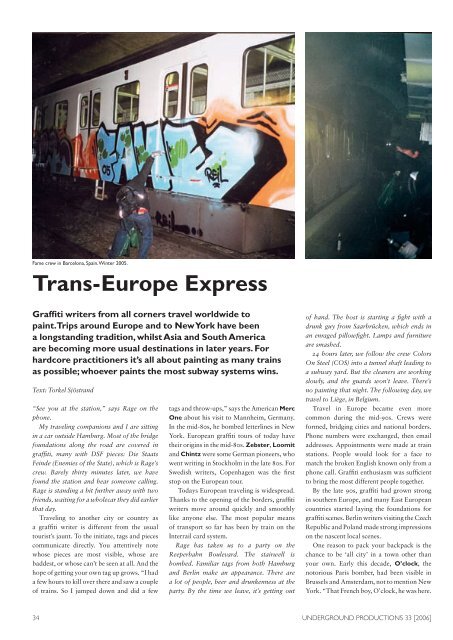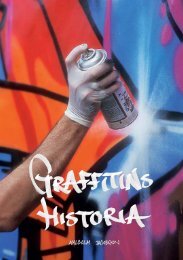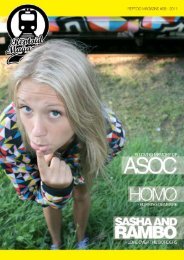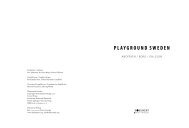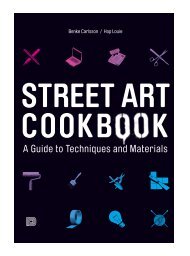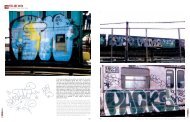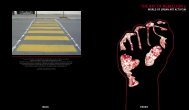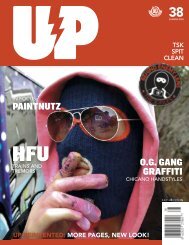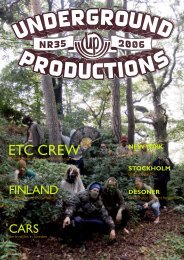BELLEVILLE IS BURNING DONUT & MARIE - Highlights.nu
BELLEVILLE IS BURNING DONUT & MARIE - Highlights.nu
BELLEVILLE IS BURNING DONUT & MARIE - Highlights.nu
Create successful ePaper yourself
Turn your PDF publications into a flip-book with our unique Google optimized e-Paper software.
Fame crew in Barcelona, Spain. Winter 2005.<br />
Trans-Europe Express<br />
Graffiti writers from all corners travel worldwide to<br />
paint. Trips around Europe and to New York have been<br />
a longstanding tradition, whilst Asia and South America<br />
are becoming more usual destinations in later years. For<br />
hardcore practitioners it’s all about painting as many trains<br />
as possible; whoever paints the most subway systems wins.<br />
Text: Torkel Sjöstrand<br />
“See you at the station,” says Rage on the<br />
phone.<br />
My traveling companions and I are sitting<br />
in a car outside Hamburg. Most of the bridge<br />
foundations along the road are covered in<br />
graffiti, many with DSF pieces: Die Staats<br />
Feinde (Enemies of the State), which is Rage’s<br />
crew. Barely thirty mi<strong>nu</strong>tes later, we have<br />
found the station and hear someone calling.<br />
Rage is standing a bit further away with two<br />
friends, waiting for a wholecar they did earlier<br />
that day.<br />
Traveling to another city or country as<br />
a graffiti writer is different from the usual<br />
tourist’s jaunt. To the initiate, tags and pieces<br />
communicate directly. You attentively note<br />
whose pieces are most visible, whose are<br />
baddest, or whose can’t be seen at all. And the<br />
hope of getting your own tag up grows. “I had<br />
a few hours to kill over there and saw a couple<br />
of trains. So I jumped down and did a few<br />
tags and throw-ups,” says the American Merc<br />
One about his visit to Mannheim, Germany.<br />
In the mid-80s, he bombed letterlines in New<br />
York. European graffiti tours of today have<br />
their origins in the mid-80s. Zebster, Loomit<br />
and Chintz were some German pioneers, who<br />
went writing in Stockholm in the late 80s. For<br />
Swedish writers, Copenhagen was the first<br />
stop on the European tour.<br />
Todays European traveling is widespread.<br />
Thanks to the opening of the borders, graffiti<br />
writers move around quickly and smoothly<br />
like anyone else. The most popular means<br />
of transport so far has been by train on the<br />
Interrail card system.<br />
Rage has taken us to a party on the<br />
Reeperbahn Boulevard. The stairwell is<br />
bombed. Familiar tags from both Hamburg<br />
and Berlin make an appearance. There are<br />
a lot of people, beer and drunkenness at the<br />
party. By the time we leave, it’s getting out<br />
of hand. The host is starting a fight with a<br />
drunk guy from Saarbrücken, which ends in<br />
an enraged pillowfight. Lamps and furniture<br />
are smashed.<br />
24 hours later, we follow the crew Colors<br />
On Steel (COS) into a tunnel shaft leading to<br />
a subway yard. But the cleaners are working<br />
slowly, and the guards won’t leave. There’s<br />
no painting that night. The following day, we<br />
travel to Liège, in Belgium.<br />
Travel in Europe became even more<br />
common during the mid-90s. Crews were<br />
formed, bridging cities and national borders.<br />
Phone <strong>nu</strong>mbers were exchanged, then email<br />
addresses. Appointments were made at train<br />
stations. People would look for a face to<br />
match the broken English known only from a<br />
phone call. Graffiti enthusiasm was sufficient<br />
to bring the most different people together.<br />
By the late 90s, graffiti had grown strong<br />
in southern Europe, and many East European<br />
countries started laying the foundations for<br />
graffiti scenes. Berlin writers visiting the Czech<br />
Republic and Poland made strong impressions<br />
on the nascent local scenes.<br />
One reason to pack your backpack is the<br />
chance to be ‘all city’ in a town other than<br />
your own. Early this decade, O’clock, the<br />
notorious Paris bomber, had been visible in<br />
Brussels and Amsterdam, not to mention New<br />
York. “That French boy, O’clock, he was here.<br />
34<br />
UNDERGROUND PRODUCTIONS 33 [2006]


